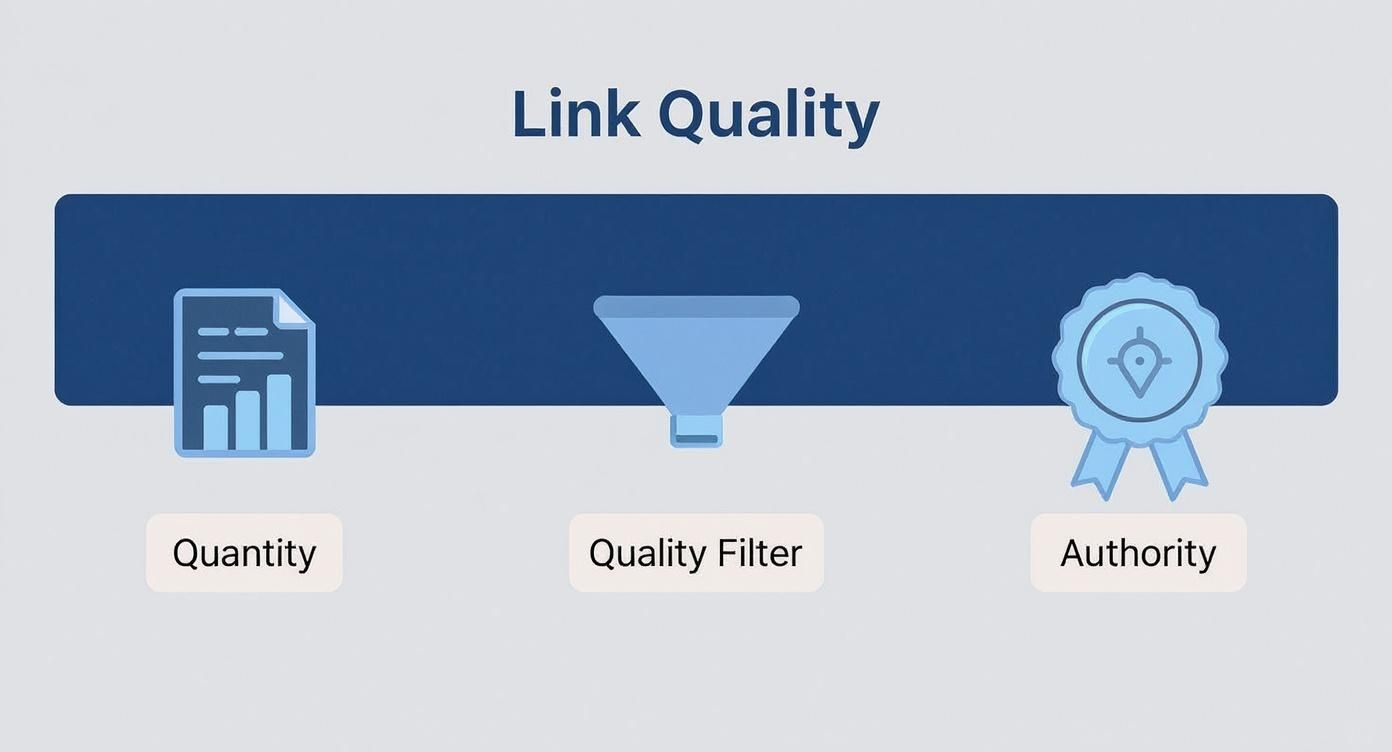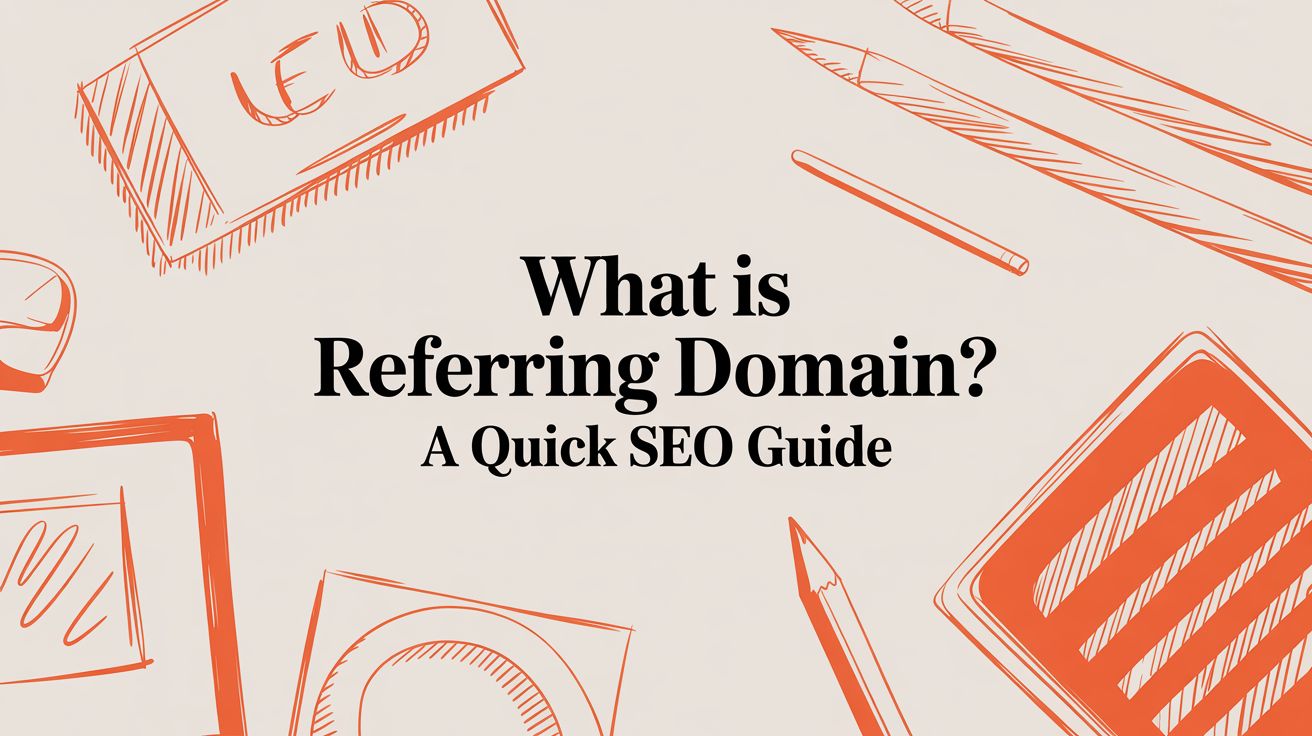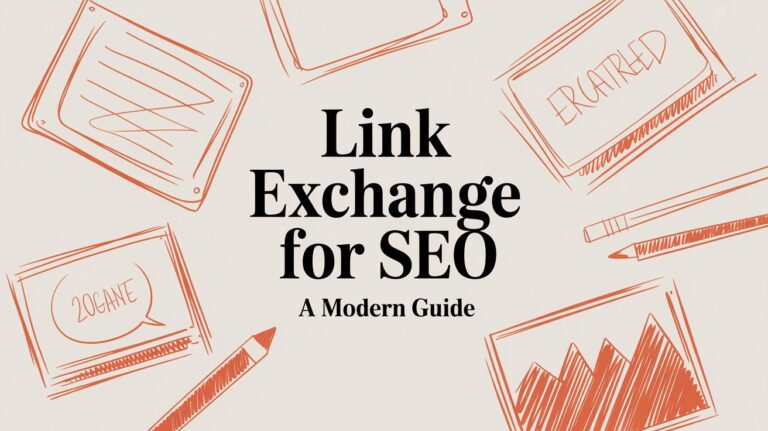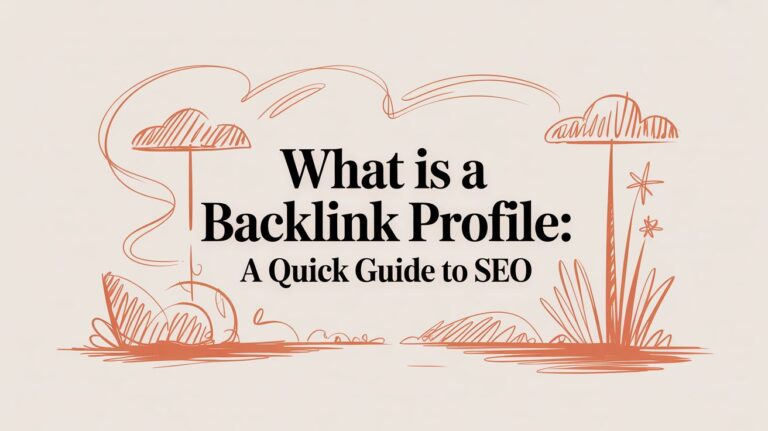What is a Referring Domain? A Quick SEO Guide
When building links for SEO, "referring domain" is the term that really matters. But what does it mean?
Think of it like recommendations. If one person tells you ten times to visit a coffee shop, that's one opinion. But if ten different people tell you it's the best coffee they've ever had, you're much more likely to believe them. That's the power of referring domains.
A referring domain is a unique website that links to your site. It's the source of the recommendation.
What Is a Referring Domain in Simple Terms
What's the difference between a referring domain and a backlink? It's a classic case of quality over quantity, and it's a distinction search engines like Google watch closely.
If TechCrunch writes an article about your startup and includes five links to your pages, you've earned five backlinks. But you only have one referring domain: TechCrunch.com.
For SEO, the number of unique referring domains is a much stronger signal of authority than the total backlink count. A diverse link profile from many sources tells search engines that your content is widely trusted. That trust is the foundation of a successful SEO campaign.
Referring Domain vs Referring Page vs Backlink
It’s easy to mix these terms up, but knowing the difference is key to a smart link-building strategy. Let's break it down.
| Term | Definition | Example |
|---|---|---|
| Referring Domain | The unique website that is the source of a backlink. | forbes.com is the referring domain. |
| Referring Page | The specific page on that website where the link is located. | forbes.com/technology/top-10-startups is the referring page. |
| Backlink | The actual hyperlink on the referring page that points to your site. | The linked text "check out this new startup" pointing to yourwebsite.com is the backlink. |
The referring domain is the "who," the referring page is the "where," and the backlink is the "what." Your goal is to get links from as many high-quality "whos" as possible.
Let's Use a Real-World Analogy
Imagine your website is a new book.
- A backlink is a single footnote in another book citing your work.
- The referring page is the specific page where that footnote appears.
- The referring domain is the entire book itself—the source of the citation.
Having one author (a referring domain) cite you ten times is great. But having ten different authors cite you in their books? That’s how you become a bestseller and signal to Google that you're an authority.
This visual from Ahrefs helps illustrate how one website can send multiple links.

The data backs this up. Pages ranking at the top of Google have, on average, 3.8 times more unique referring domains than those ranking lower. You can discover more SEO statistics on SearchAtlas that confirm this trend.
The takeaway is simple: a broad portfolio of referring domains is one of the strongest indicators of a website's authority and a direct driver of higher search rankings.
Why Referring Domains Are a Cornerstone of SEO

Why should you care about referring domains? Because search engines see each unique website linking to you as a vote of confidence. It's not just about the link; it's about who is casting the vote.
When a respected site links to you, it's telling Google, "Hey, this site knows what it's talking about." The more distinct, high-quality sites vouching for you, the more authority you build in Google's eyes. This authority is a major factor in how you rank for your most important keywords.
This concept is called link equity. Every link from a new, relevant domain passes some of this equity to your site, giving it a direct boost.
Building Trust and Topical Relevance
A healthy mix of referring domains also helps Google understand your website's topic. When other sites in your niche link to you, it sends a clear signal about your area of expertise.
For example, if you run a SaaS company and get links from tech blogs and software review sites, Google understands you're a serious player in the software industry. These links establish your topical authority, making it easier to rank for terms your customers search for.
This builds trust not just with search engines, but with your audience too. A visitor who clicks from a source they already trust is more likely to become a customer.
A strong profile of referring domains acts as a competitive moat. It protects your search rankings from algorithm updates and makes it harder for competitors to outperform you.
How Referring Domains Drive Growth
A strong referring domain profile is an engine for business growth. Every link is a new doorway for potential customers, creating a consistent flow of referral traffic. This traffic is often highly qualified because it comes from an audience already interested in your topic.
This creates a self-sustaining growth loop with huge benefits:
- Improved Search Rankings: A high count of quality referring domains strongly correlates with top-ranking pages.
- Increased Organic Traffic: Better rankings mean more visibility and more clicks from search results.
- Enhanced Brand Credibility: When authoritative sites cite you, it positions your brand as a leader.
- Direct Referral Traffic: Each link is a potential source of valuable, targeted visitors.
To get this right, you also need to understand the different types of links and how they fit into a bigger strategy. By focusing on earning links from a wide range of quality domains, you’re building a long-term asset that will fuel your growth for years.
Quality Always Wins Over Quantity
In SEO, it's tempting to chase big numbers. But with referring domains, that's a mistake. A single link from an authoritative website is worth more than a hundred links from low-quality sites.
Think of it like a business recommendation. Would you prefer a glowing testimonial from a top expert or a bunch of five-star reviews from anonymous accounts? The answer is obvious, and search engines see it the same way.
Google's algorithm is built on trust. A link from a credible website is a massive vote of confidence. On the other hand, links from shady or irrelevant sites are, at best, ignored and, at worst, can make your site look suspicious.
What Makes a Referring Domain "High-Quality"?
So, what separates a great referring domain from a bad one? It comes down to a few key signals Google uses to measure credibility.
Here’s what to look for:
- Topical Relevance: Does the linking site talk about the same things you do? A link from a top marketing blog to a marketing SaaS tool is a perfect match.
- Domain Authority: Is the website a respected player? Metrics like Ahrefs' Domain Rating (DR) or Semrush's Authority Score (AS) help gauge a site's strength.
- Trustworthiness: A quality site looks legitimate. It has valuable content, isn't covered in ads, and doesn't link to sketchy websites. It’s a real source of information.
You're trying to earn endorsements from established leaders in your space. Each time one of them links to you, some of their credibility transfers to your site.
Your Strategy: Think Diversity and Quality
Beyond the quality of a single domain, you need a diverse link profile. Imagine two websites: one has 100 links from just three blogs. The other has 100 links from 50 different, relevant websites. Who do you think Google trusts more?
It’s the second one, every time. This isn't a new concept. If you explore SEO statistics on SearchAtlas, you'll see how critical a diverse link profile has become.
Your goal is to build a portfolio of strong, credible endorsements. Every high-quality referring domain is another pillar supporting your website's authority, creating a solid foundation that helps you climb the rankings and stay there.
How to Analyze Your Referring Domain Profile
Knowing what a referring domain is is the first step. The real magic happens when you see who’s linking to you. Analyzing your referring domain profile is like running a background check on your website's reputation—it reveals your biggest advocates, flags potential risks, and shows how you compare to competitors.
SEO platforms like Ahrefs, Semrush, or Moz are built for this. Just enter your domain to get a comprehensive report that can guide your link-building strategy.
Identifying Your Most Valuable Domains
First, find your VIPs—the most authoritative websites linking to you. These are the heavy hitters propping up your site's authority.
In your SEO tool, sort the list of referring domains by a metric like Domain Rating (DR) or Authority Score (AS). The sites at the top are your most powerful allies. A single link from a high-authority site in your niche can be worth more than dozens of links from obscure blogs. Understanding who these key players are helps you see what's working so you can find more like them.

Spotting Potentially Harmful Links
Not all links are good links. A proper audit means sniffing out toxic or spammy referring domains that could be hurting your site. These often come from low-quality, irrelevant sites built for manipulative link schemes.
Most tools flag risky links, often with a "Toxicity Score." If you see a sudden surge of links from domains unrelated to your industry or that just look sketchy, take a closer look. A buildup of bad links can risk a Google penalty that could damage your rankings. For a deeper dive, check out our guide on what is a backlink profile.
Benchmarking Against Competitors
Finally, no analysis is complete without checking your competition. Running the same reports on your top rivals is one of the best ways to uncover strategic opportunities.
By analyzing who links to them but not to you, you can reverse-engineer their success. This gives you a ready-made list of high-value websites to target for your own campaigns. It's not about copying them; it's about finding gaps in your strategy and creating a roadmap to close them.
Actionable Strategies to Earn High-Quality Domains

Running an audit is the easy part. The real work is earning new, high-quality referring domains. This isn't about finding shortcuts; it's about making your website an undeniable source of value.
Your goal is to create content so good that other sites want to link to you. It's a shift from link building to link earning. The best links come from producing exceptional work and building real relationships.
Create Genuinely Link-Worthy Content
The most effective way to attract powerful referring domains is to create content that’s too good to ignore. These "linkable assets" are the kind of resources that people in your industry can't help but reference.
Formats that consistently work well:
- Original Data and Research: Run your own surveys or analyze industry data. Journalists and bloggers always need fresh statistics to back up their claims, which can land you links from major news sites.
- Ultimate Guides and Resources: Pick a core topic in your niche and create the most comprehensive guide available. When you become the go-to authority, you become the go-to source for others writing about it.
- Free Tools and Calculators: Solve a recurring problem for your audience with a simple tool, like a project ROI calculator. These resources provide tangible value and attract links for years.
Master Strategic Outreach and Collaboration
Even the best content needs a push. Once you have a valuable asset, put it in front of the right people. This isn't about sending mass emails; it's about building targeted, personal connections with journalists, editors, and creators in your space.
Guest posting on respected websites is another great way to get noticed. It lets you share your expertise with an established audience while earning a link back to your site. Focus on providing genuine value, not just dropping a link. Similarly, securing niche edit links is a smart tactic for getting your URL placed within relevant, existing articles.
The secret to earning great links is reciprocity. When you focus on providing immense value to others, high-quality referring domains follow.
Leverage Digital PR for Natural Media Coverage
Digital Public Relations (PR) is about getting your brand mentioned organically in online publications. The strategy is to create newsworthy stories, offer expert commentary, or share compelling data that journalists want to cover.
Ask yourself what unique insights your company has. Can you comment on breaking news in your field? Do you have internal data that reveals a surprising trend? Pitching these angles to journalists can earn you high-authority links from trusted domains.
The opportunities are growing. The domain name registrar market is expected to surpass $3.9 billion globally by 2033. This growth in the domain market means more potential sites to earn links from, making it even more important to stand out with quality.
Got Questions About Referring Domains? We've Got Answers.
Here are a few common questions that often come up about referring domains.
So, What's the Magic Number of Referring Domains?
Everyone wants a magic number, but there isn't one. The "right" number of referring domains is relative. It depends on your niche, your target keywords, and your competition.
Instead of chasing a number, aim for quality. A handful of powerful links from industry authorities is better than hundreds of links from spammy sites.
A better approach: analyze the sites already on the first page for your target keywords. See what their referring domain profiles look like. That's your benchmark. Aim for that level of quality and diversity.
Can Referring Domains Actually Hurt My SEO?
Yes, they absolutely can. A sudden influx of links from low-quality, spammy, or unrelated websites is a huge red flag for Google. It looks like you're trying to manipulate the system, which can lead to a penalty that hurts your rankings.
It's not just about getting new links; it's about protecting your site from bad ones. Regularly auditing your referring domains is non-negotiable.
If you find toxic links, don't ignore them. Use Google's Disavow Tool to tell the search engine you don't endorse those links. This crucial maintenance keeps your backlink profile healthy.
What's the Deal with "New" vs. "Lost" Domains?
In your SEO tools, you'll see metrics for "new" and "lost" referring domains. Watching this flow helps measure your link-building momentum.
-
New Referring Domains: These are sites that linked to you for the first time in a given period (e.g., the last 30 days). A steady stream of new domains is a great sign that your content is being discovered.
-
Lost Referring Domains: These are sites that used to link to you but have since removed all links pointing to your site. This happens when a site is redesigned or content is updated.
A sudden spike in lost domains could mean a high-value link vanished. That’s your cue to investigate and see if you can get it back. It’s a constant cycle of earning new trust while maintaining the trust you've already built.
Ready to stop chasing links and start earning them on autopilot? BlazeHive uses AI to match you with relevant websites in your niche, making it simple to build a powerful referring domain profile without the manual grind. Start building your authority today.







